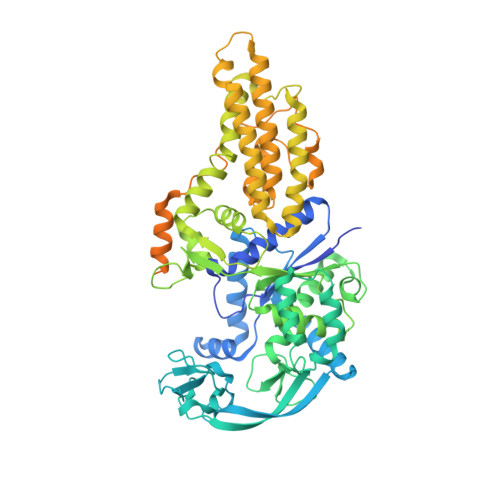Molecular basis for diaryldiamine selectivity and competition with tRNA in a type 2 methionyl-tRNA synthetase from a Gram-negative bacterium.
Mercaldi, G.F., Andrade, M.O., Zanella, J.L., Cordeiro, A.T., Benedetti, C.E.(2021) J Biological Chem 296: 100658-100658
- PubMed: 33857480
- DOI: https://doi.org/10.1016/j.jbc.2021.100658
- Primary Citation of Related Structures:
6WQ6, 6WQI, 6WQS, 6WQT - PubMed Abstract:
Gram-negative bacteria are responsible for a variety of human, animal, and plant diseases. The spread of multidrug-resistant Gram-negative bacteria poses a challenge to disease control and highlights the need for novel antimicrobials. Owing to their critical role in protein synthesis, aminoacyl-tRNA synthetases, including the methionyl-tRNA synthetases MetRS1 and MetRS2, are attractive drug targets. MetRS1 has long been exploited as a drug target in Gram-positive bacteria and protozoan parasites. However, MetRS1 inhibitors have limited action upon Gram-negative pathogens or on Gram-positive bacteria that produce MetRS2 enzymes. The underlying mechanism by which MetRS2 enzymes are insensitive to MetRS1 inhibitors is presently unknown. Herein, we report the first structures of MetRS2 from a multidrug-resistant Gram-negative bacterium in its ligand-free state and bound to its substrate or MetRS1 inhibitors. The structures reveal the binding mode of two diaryldiamine MetRS1 inhibitors that occupy the amino acid-binding site and a surrounding auxiliary pocket implicated in tRNA acceptor arm binding. The structural features associated with amino acid polymorphisms found in the methionine and auxiliary pockets reveal the molecular basis for diaryldiamine binding and selectivity between MetRS1 and MetRS2 enzymes. Moreover, we show that mutations in key polymorphic residues in the methionine and auxiliary pockets not only altered inhibitor binding affinity but also significantly reduced enzyme function. Our findings thus reinforce the tRNA acceptor arm binding site as a druggable pocket in class I aminoacyl-tRNA synthetases and provide a structural basis for optimization of MetRS2 inhibitors for the development of new antimicrobials against Gram-negative pathogens.
Organizational Affiliation:
Brazilian Biosciences National Laboratory (LNBio), Brazilian Centre for Research in Energy and Materials (CNPEM), Campinas, SP, Brazil. Electronic address: gustavo.mercaldi@lnbio.cnpem.br.




















